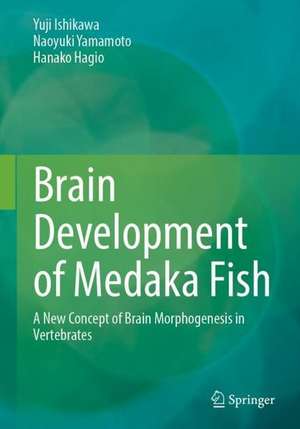Brain Development of Medaka Fish: A New Concept of Brain Morphogenesis in Vertebrates
Autor Yuji Ishikawa, Naoyuki Yamamoto, Hanako Hagioen Limba Engleză Hardback – 7 oct 2022
This book describes the developmental process of the brain of the medaka fish. It aims to understand the brain structure of vertebrates, including humans, by taking the brain of the medaka fish as an example and showing its actual developmental process. From developmental and evolutionary viewpoints, the understanding of the brain proceeds from simple to complex structures. Fish retain the basic form of vertebrates, and their brain morphology is relatively simple. Therefore, the fish brain is useful in understanding the brain structure. This book is unique for describing the entire process of the brain development in a specific fish.
In addition, the book introduces the readers to a new concept of “Hourglass of Brain Morphogenesis”, concerning the general rule of brain morphogenesis in vertebrates. The authors propose that the brain morphology is highly conserved at the middle developmental stage but diverges more extensively at earlier and later stages. The new concept challenges the accepted theory that has been widely shared for about 200 years since K. von Baer (1828, 1837) and K. von Kupffer (1906) who proposed that three primary brain vesicles at earlier developmental stages develop into five secondary brain vesicles at later developmental stages in all vertebrates.
The book provides a basic understanding of the vertebrate brain and is useful for all readers who wish to understand the complex structure of the brain.
| Toate formatele și edițiile | Preț | Express |
|---|---|---|
| Paperback (1) | 563.04 lei 38-44 zile | |
| Springer Nature Singapore – 8 oct 2023 | 563.04 lei 38-44 zile | |
| Hardback (1) | 652.31 lei 3-5 săpt. | |
| Springer Nature Singapore – 7 oct 2022 | 652.31 lei 3-5 săpt. |
Preț: 652.31 lei
Preț vechi: 767.42 lei
-15% Nou
Puncte Express: 978
Preț estimativ în valută:
124.84€ • 129.85$ • 103.06£
124.84€ • 129.85$ • 103.06£
Carte disponibilă
Livrare economică 24 martie-07 aprilie
Preluare comenzi: 021 569.72.76
Specificații
ISBN-13: 9789811943232
ISBN-10: 9811943230
Pagini: 256
Ilustrații: XIV, 256 p. 1 illus.
Dimensiuni: 178 x 254 mm
Greutate: 0.75 kg
Ediția:1st ed. 2022
Editura: Springer Nature Singapore
Colecția Springer
Locul publicării:Singapore, Singapore
ISBN-10: 9811943230
Pagini: 256
Ilustrații: XIV, 256 p. 1 illus.
Dimensiuni: 178 x 254 mm
Greutate: 0.75 kg
Ediția:1st ed. 2022
Editura: Springer Nature Singapore
Colecția Springer
Locul publicării:Singapore, Singapore
Cuprins
Chapter 1. Introduction.- Chapter 2.General Rules of Brain Morphogenesis in Vertebrates: An Hourglass Model.- Chapter 3.Neural Tube Formation.- Chapter 4.Subdivisions of Neural tube along the Dorsoventral Axis.- Chapter 5. Subdivisions of Neural Tube along the Rostrocaudal Axis: Neuromeric Models.- Chapter 6.Left-right Patterning of Neural Tube.- Chapter 7. Ventriculo-pial Patterning of Neural Tube.- Chapter 8.Development of Neural Circuits in Neural Tube.- Chapter 9.From Neural Tube to Larval Brain: Blood Vessels and Proliferative Zones.- Chapter 10. Development of Telencephalon.- Chapter 11. Development of Diencephalon, Optic Tectum, and Cerebellum.- Chapter 12. Nervous System in Medaka Larvae.- Chapter 13.From Larval Brain to Adult Brain and Summary of Telencephalic Ontogenesis.- Chapter 14. Adult Brain and General Brain Functions.- Chapter 15. Functional Neuroanatomy of Teleost Brains.
Notă biografică
Yuji Ishikawa was an Associate Professor at the Department of Anatomy, Faculty of Medicine, University of the Ryukyus, Okinawa, Japan (1985-1992) and a Researcher at National Institute of Radiological Sciences, Chiba, Japan (1992-2016). His research interests include developmental biology and developmental neurobiology, especially the developmental neurotoxic effects of radiation. Naoyuki Yamamoto is a Professor at the Graduate School of Bioagricultural Sciences, Nagoya University, Japan since 2007. His research interests include sensory, motor, and nervous system, behavior, and their evolution of fishes. He is on the editorial board of Brain, Behavior and Evolution since 2004 and The Journal of Comparative Neurology since 2010.
Hanako Hagio is a Designated Assistant Professor at Young Leaders Cultivation Program (YLC), Institute for Advanced Research and Graduate School of Bioagricultural Sciences, Nagoya University, Japan since 2020. Her research interests include the evolution and functions of central visual system in fishes, and fisheries science from the points of view of sensory and nervous systems.
Textul de pe ultima copertă
This book describes the developmental process of the brain of the medaka fish. It aims to understand the brain structure of vertebrates, including humans, by taking the brain of the medaka fish as an example and showing its actual developmental process. From developmental and evolutionary viewpoints, the understanding of the brain proceeds from simple to complex structures. Fish retain the basic form of vertebrates, and their brain morphology is relatively simple. Therefore, the fish brain is useful in understanding the brain structure. This book is unique for describing the entire process of the brain development in a specific fish.
In addition, the book introduces the readers to a new concept of “Hourglass of Brain Morphogenesis”, concerning the general rule of brain morphogenesis in vertebrates. The authors propose that the brain morphology is highly conserved at the middle developmental stage but diverges more extensively at earlier and later stages. The new concept challenges the accepted theory that has been widely shared for about 200 years since K. von Baer (1828, 1837) and K. von Kupffer (1906) who proposed that three primary brain vesicles at earlier developmental stages develop into five secondary brain vesicles at later developmental stages in all vertebrates.
The book provides a basic understanding of the vertebrate brain and is useful for all readers who wish to understand the complex structure of the brain.
Caracteristici
Includes detailed and comprehensive description of the development of the medaka brain Provides a comprehensive brain atlas of the larval medaka brain Presents a new concept of the “hourglass model” for the general rule of brain morphogenesis in vertebrates
